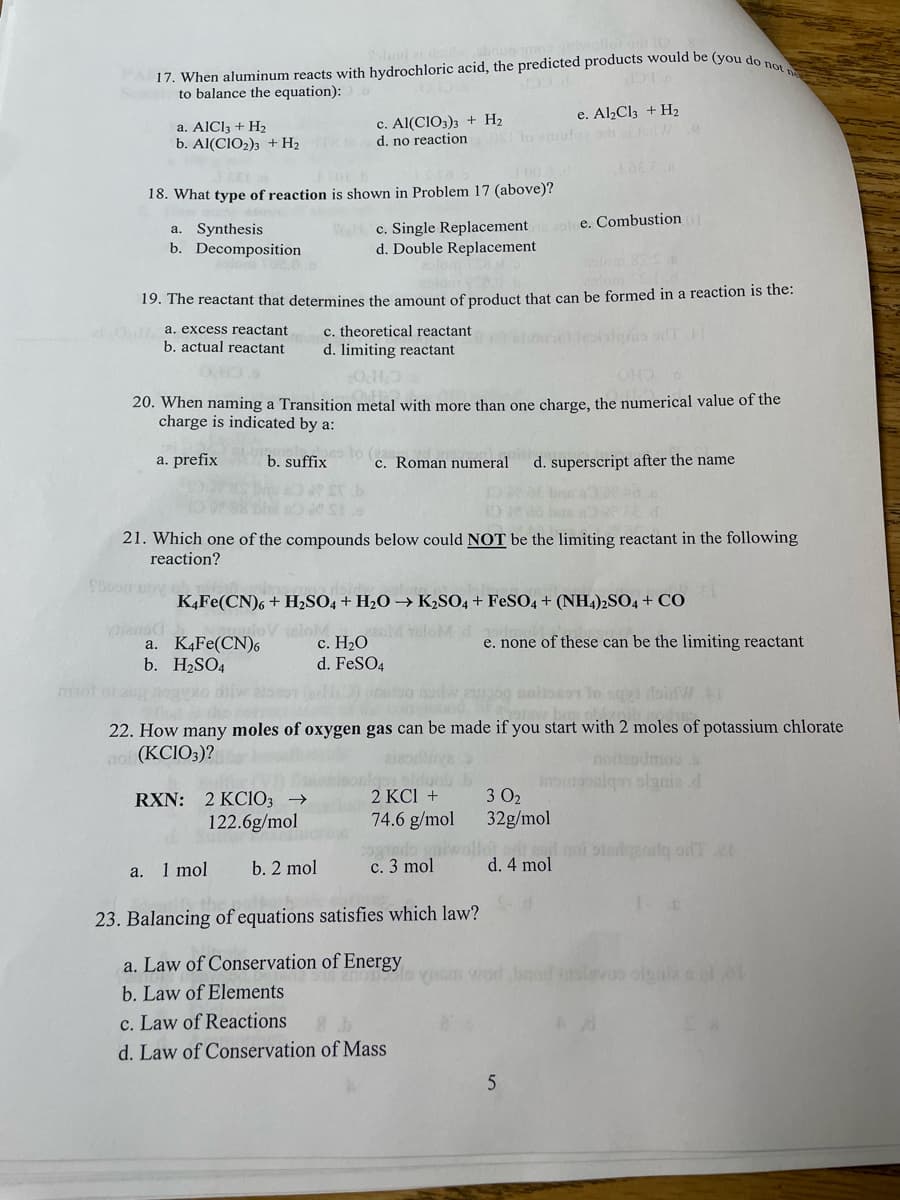17. When aluminum reacts with hydrochloric acid, the predicted products would be (you do not n to balance the equation): po a. AlCl3 + H₂ e. Al₂Cl3 + H₂ c. Al(CIO3)3 + H₂ d. no reaction b. Al(CIO2)3 + H₂ 18. What type of reaction is shown in Problem 17 (above)? a. Synthesis c. Single Replacement e. Combustion b. Decomposition d. Double Replacement 19. The reactant that determines the amount of product that can be formed in a reaction is the:
17. When aluminum reacts with hydrochloric acid, the predicted products would be (you do not n to balance the equation): po a. AlCl3 + H₂ e. Al₂Cl3 + H₂ c. Al(CIO3)3 + H₂ d. no reaction b. Al(CIO2)3 + H₂ 18. What type of reaction is shown in Problem 17 (above)? a. Synthesis c. Single Replacement e. Combustion b. Decomposition d. Double Replacement 19. The reactant that determines the amount of product that can be formed in a reaction is the:
Chemistry: Principles and Reactions
8th Edition
ISBN:9781305079373
Author:William L. Masterton, Cecile N. Hurley
Publisher:William L. Masterton, Cecile N. Hurley
Chapter21: Chemistry Of The Nonmetals
Section: Chapter Questions
Problem 73QAP: The amount of sodium hypochlorite in a bleach solution can be determined by using a given volume of...
Related questions
Question
need all of them answered please correctly

Transcribed Image Text:17. When aluminum reacts with hydrochloric acid, the predicted products would be (you do not ne
to balance the equation):
a. AlCl3 + H₂
c. Al(CIO3)3 + H₂
e. Al₂Cl3 + H₂
och as Jer W
b. Al(CIO₂)3 + H₂ d. no reaction
1002
18. What type of reaction is shown in Problem 17 (above)?
a. Synthesis
Hc. Single Replacement
e. Combustion
b. Decomposition
d. Double Replacement
19. The reactant that determines the amount of product that can be formed in a reaction is the:
2a. excess reactant
b. actual reactant
c. theoretical reactant
d. limiting reactant
OHO s
OH
20. When naming a Transition metal with more than one charge, the numerical value of the
charge is indicated by a:
a. prefix
b. suffix
c. Roman numeral
supers after the name
10 Nº ad
21. Which one of the compounds below could NOT be the limiting reactant in the following
reaction?
Shoom woy of
K4Fe(CN)6+ H₂SO4 + H₂O → K₂SO4 + FeSO4 + (NH4)2SO4 + CO
diens
lov islom
a.
K4Fe(CN)6
e. none of these can be the limiting reactant
b. H₂SO4
c. H₂O
d. FeSO4
mol
(0) onsho
isor to sqyi doidW
de com
22. How many moles of oxygen gas can be made if you start with 2 moles of potassium chlorate
(KCIO3)?
noitendmos s
insonigon slania d
RXN: 2 KC103 →
2 KCl +
74.6 g/mol
3 0₂
32g/mol
122.6g/mol
cogrado gniw
c. 3 mol
oft and not
d. 4 mol
postq ofTet
a. 1 mol
b. 2 mol
1-c
23. Balancing of equations satisfies which law?
a. Law of Conservation of Energy
word brod inslavos olgnia a glo
b. Law of Elements
c. Law of Reactions
d. Law of Conservation of Mass
5
Expert Solution
This question has been solved!
Explore an expertly crafted, step-by-step solution for a thorough understanding of key concepts.
Step by step
Solved in 2 steps with 1 images

Knowledge Booster
Learn more about
Need a deep-dive on the concept behind this application? Look no further. Learn more about this topic, chemistry and related others by exploring similar questions and additional content below.Recommended textbooks for you

Chemistry: Principles and Reactions
Chemistry
ISBN:
9781305079373
Author:
William L. Masterton, Cecile N. Hurley
Publisher:
Cengage Learning

Chemistry & Chemical Reactivity
Chemistry
ISBN:
9781337399074
Author:
John C. Kotz, Paul M. Treichel, John Townsend, David Treichel
Publisher:
Cengage Learning

Chemistry & Chemical Reactivity
Chemistry
ISBN:
9781133949640
Author:
John C. Kotz, Paul M. Treichel, John Townsend, David Treichel
Publisher:
Cengage Learning

Chemistry: Principles and Reactions
Chemistry
ISBN:
9781305079373
Author:
William L. Masterton, Cecile N. Hurley
Publisher:
Cengage Learning

Chemistry & Chemical Reactivity
Chemistry
ISBN:
9781337399074
Author:
John C. Kotz, Paul M. Treichel, John Townsend, David Treichel
Publisher:
Cengage Learning

Chemistry & Chemical Reactivity
Chemistry
ISBN:
9781133949640
Author:
John C. Kotz, Paul M. Treichel, John Townsend, David Treichel
Publisher:
Cengage Learning

General Chemistry - Standalone book (MindTap Cour…
Chemistry
ISBN:
9781305580343
Author:
Steven D. Gammon, Ebbing, Darrell Ebbing, Steven D., Darrell; Gammon, Darrell Ebbing; Steven D. Gammon, Darrell D.; Gammon, Ebbing; Steven D. Gammon; Darrell
Publisher:
Cengage Learning

Chemistry
Chemistry
ISBN:
9781305957404
Author:
Steven S. Zumdahl, Susan A. Zumdahl, Donald J. DeCoste
Publisher:
Cengage Learning

Chemistry: An Atoms First Approach
Chemistry
ISBN:
9781305079243
Author:
Steven S. Zumdahl, Susan A. Zumdahl
Publisher:
Cengage Learning